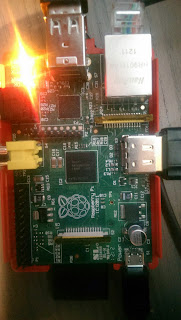
I set it up at work. Was good and didn't get too distracted, but I did load up Debian and have a play. It's not quick for sure - loading Incentivated's website took about 30 s, and the CPU was at 100 % for most of that time, but that's to be expected I guess.
After a while I tried out the Arch Linux Arm version, which doesn't by default have a GUI, but seems pretty nice. I'm going to stick with that for now.
Now I've got it home, I've got it running on my desk with Arch Linux, bought an HDMI-DVI adaptor and a cheap HDMI cable, which works fine.
I've rebuild the Arch Linux image with larger partitions - I was lazy and did it with a VM running Ubuntu and gparted - 6 Gb root partition, and the rest of the 16 Gb card as data (I'll be symlinking /home and /var).
I've been brainstorming things to do with it. Ideas so far include:
- Fishtank automation (Temperature, pH, salinity measurements, light & heater controls)
- Media centre - somehow - more on this later - I have an awesome idea :)
- Time machine / backup for my life (in other words, my Macbook Pro)
- Random web console for when I need such a thing and my laptop is elsewhere - I think I'm going to buy one just for this purpose anyway
Anyway, enough talking, back to some doing! I'll post more here about the media centre idea soon.
Web console and media player for sure. I used to have a linux box running 24x7 but the electricity was pointless. Love the thought of always on gateway using a phone charger. It also makes running an email server possible which I'll also have a crack at. Do you know if debian lets you control power to external usb drives? I'd like to have the media disk powered down until needed - I've tried with my win7 xbmc boxes but evev when they sleep the drive spins.
ReplyDeleteGood posts, thanks
Mike Bakke @mikebakke
There is a certain amount of power management in most USB powered drives, though it varies from vendor to vendor (in fact there is a known issue with some Seagate drives that I've encountered before that means they don't power up again on Linux, which can be worked around).
DeleteI want to investigate the options here myself, when I do so I will be sure to post here, though for me, the NAS function in my house may well be handled by a DD-WRT router rather than the Pi; not sure yet (may still use the Pi for media).
Appreciate the comment